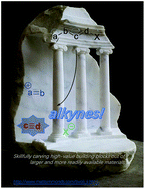Alkynogenic fragmentation
Abstract
Fragmentation reactions in synthetic organic chemistry involve substrates breaking into three or more pieces (fragments), adding degrees of unsaturation into two or more parts. Most examples of fragmentation reactions generate alkenes from saturated substrates. Those fragmentation reactions that generate alkynes are typically discussed as an extension of alkene-generating fragmentation reactions, perhaps due to some clear mechanistic parallels. However, alkyne-generating (alkynogenic) fragmentation reactions require distinct strategic and tactical considerations, and observations from the broader class of fragmentation examples do not immediately translate. Whereas establishing proper orbital alignment through substrate conformational control is a primary consideration for promoting alkene-generating fragmentations, orbital alignment is generally pre-ordained by unsaturation in the alkynogenic fragmentation substrate, and overcoming the enthalpic barriers associated with breaking strong bonds to sp2-hybridized carbon atoms is key. Elevated temperature and judicious selection of nucleofuge (terminal leaving group) is often required, but the pay-off can be high-value alkynes for chemical synthesis that are not readily available directly from acetylene. This review covers historic and more recent contributions to a specific class of reactions referred to as alkynogenic fragmentations.

- This article is part of the themed collection: 2019 Organic Chemistry Frontiers Review-type Articles


 Please wait while we load your content...
Please wait while we load your content...
